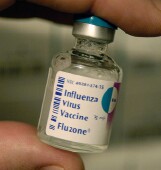
MONDAY, Nov. 1 (HealthDay News) — Among children hospitalized with the pandemic H1N1 flu last year in California, more than one-fourth ended up in intensive care units or died, California Department of Public Health researchers report.
“While hospitalization for 2009 H1N1 influenza in children appeared to occur at similar rates as with seasonal influenza, this study provides further evidence that children, especially those with high-risk conditions, can be very ill with H1N1,” said lead researcher Dr. Janice K. Louie.
“Fortunately, not many children died. Those that did had many underlying conditions. Antiviral medication given early seems to have lessened the chance of severe illness,” she added.
Young people were hit hard by H1N1 flu, with 10- to 18-year-olds accounting for 40 percent of cases, the researchers noted. This was most likely due to a lack of immunity, which older people acquired through repeated flu vaccinations of different strains of H1N1 or exposure to other H1N1 strains, the experts pointed out.
Flu experts don’t anticipate the H1N1 flu will pose a serious threat in the 2010-2011 flu season, but the study authors say doctors should promptly treat children with underlying risk factors, especially infants, who get the flu.
“My feeling is that we are over the hump,” said Dr. Marc Siegel, an associate professor of medicine at New York University in New York City. “I am expecting this to be part of the seasonal flu this year, unless it mutates,” he said.
The many people exposed to the H1N1 flu and the sizable number vaccinated against it have created a large herd immunity, which should blunt this flu strain, Siegel said.
In addition, the current seasonal flu vaccine, which is recommended for everyone 6 months old and up, contains protection from H1N1 flu, he noted.
For the study, published in the November issue of the Archives of Pediatrics and Adolescent Medicine, Louie’s team examined the medical records of 345 children who were hospitalized or died from the H1N1 flu between April 23 and Aug. 11 of 2009. Their median age was 6 years.
During that time, 3.5 per 100,000 children were hospitalized, most younger than 6 months, the researchers noted.
Most of these children (67 percent) suffered from other health problems as well as the flu. Nearly 60 percent had pneumonia, 27 percent were admitted to an intensive care unit and 3 percent died, Louie’s group found.
“Overall, rates of hospitalization in this case series were similar to seasonal influenza, with infants under 12 months of age having the highest rates,” Louie said.
Sixty-nine percent were treated with antiviral drugs, the study authors reported. “Children who had a positive rapid test or who were treated with antivirals early in their illness were less likely to require intensive care unit admission or die,” Louie said.
Intensive care hospitalization and death were more likely among children with heart disease, cerebral palsy or developmental problems, the authors added.
Hispanic and black children were less likely to die or need intensive care than white children, Louie’s team said.
“For children with influenza-like symptoms, especially those with high-risk conditions, clinicians should have high suspicion for infection with influenza,” Louie said. And parents should get their children, especially those with underlying health issues, vaccinated against the flu, she stressed.
In another report in the same journal issue, researchers looked at children hospitalized for H1N1 flu in Israel. Dr. Michal Stein of Edith Wolfson Medical Center in Holon, Israel, and colleagues found the number of children hospitalized and the severity of illness were similar to the findings in the study by Louie and colleagues.
“In conclusion, our study showed that the severity and mortality of 2009 influenza A (H1N1) in Israel were milder than those described in earlier publications and were similar to the figures reported in the literature on seasonal influenza,” the researchers wrote.
“Children with underlying metabolic and neurologic disorders represent the group at highest risk for severe complications following 2009 influenza A (H1N1) infection,” they concluded.
More information
For more information on H1N1 flu, visit Flu.gov.

